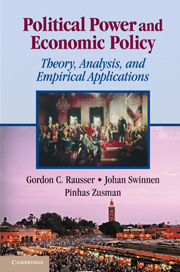Book contents
- Frontmatter
- Contents
- List of Figures
- List of Tables
- Preface
- PART 1 POLITICAL POWER AND ECONOMIC ANALYSIS
- PART 2 IDEOLOGY, PRESCRIPTION, AND POLITICAL POWER COEFFICIENTS
- PART 3 ANALYSIS OF SPECIFIC STRUCTURES
- 10 The Political Economy of Commodity Market Intervention
- 11 The Political Economy of Public Research and Development
- 12 Political-Economic Analysis of Redistributive Policies and Public Good Investments
- 13 Interest Groups, Coalition Breaking, and Productive Policies
- 14 Policy Reform and Compensation
- 15 Political-Economic Analysis of Land Reform
- 16 Political-Economic Analysis of Water Resource Systems
- 17 The Political Economy Lens on Quality and Public Standard Regulations
- 18 Political-Economic Analysis in Transition Economies
- 19 The Power of Bureaucracies: The European Commission and EU Policy Reforms
- PART 4 EMPIRICAL APPLICATIONS OF POLITICAL POWER ESTIMATION
- References
- Index
15 - Political-Economic Analysis of Land Reform
Published online by Cambridge University Press: 05 June 2012
- Frontmatter
- Contents
- List of Figures
- List of Tables
- Preface
- PART 1 POLITICAL POWER AND ECONOMIC ANALYSIS
- PART 2 IDEOLOGY, PRESCRIPTION, AND POLITICAL POWER COEFFICIENTS
- PART 3 ANALYSIS OF SPECIFIC STRUCTURES
- 10 The Political Economy of Commodity Market Intervention
- 11 The Political Economy of Public Research and Development
- 12 Political-Economic Analysis of Redistributive Policies and Public Good Investments
- 13 Interest Groups, Coalition Breaking, and Productive Policies
- 14 Policy Reform and Compensation
- 15 Political-Economic Analysis of Land Reform
- 16 Political-Economic Analysis of Water Resource Systems
- 17 The Political Economy Lens on Quality and Public Standard Regulations
- 18 Political-Economic Analysis in Transition Economies
- 19 The Power of Bureaucracies: The European Commission and EU Policy Reforms
- PART 4 EMPIRICAL APPLICATIONS OF POLITICAL POWER ESTIMATION
- References
- Index
Summary
Introduction
Generally, land reform involves significant changes in the distribution of property rights in land, as well as a variety of constraints imposed on land tenure contracts and the contractual rights that they confer. At the outset, land reforms associated with the transition from feudal and semifeudal property relations to capitalistic modes of production primarily entailed alteration in the distribution of property rights in human resources between lords and peasants. These historical reforms aimed at eliminating bonded labor arrangements. Although recent land reforms ordinarily focus on tenure relations, they are often combined with supplementary policy measures such as infrastructural development, establishment of rural credit institutions, agricultural extension, and the provision of various rural social services (health, education, etc.)
It has long been recognized that “the process of acquiring and defending rights in land is inherently a political process based on power relations among members of the social group … A person's status … can and often does determine his or her capacity to engage in tenure building” (Bassett and Crummey 1993: 20). The aim of the present chapter is to apply the political power theoretic approach to political economies to the analysis of land reforms. As will be demonstrated, the political power theoretic approach offers a useful conceptual framework for an exhaustive and systematic analysis of the political economy of land reform.
- Type
- Chapter
- Information
- Political Power and Economic PolicyTheory, Analysis, and Empirical Applications, pp. 282 - 305Publisher: Cambridge University PressPrint publication year: 2011



